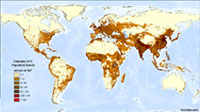2.27: Evolution of Humans and the Rise of Modern Civilization
- Page ID
- 9796
\( \newcommand{\vecs}[1]{\overset { \scriptstyle \rightharpoonup} {\mathbf{#1}} } \)
\( \newcommand{\vecd}[1]{\overset{-\!-\!\rightharpoonup}{\vphantom{a}\smash {#1}}} \)
\( \newcommand{\id}{\mathrm{id}}\) \( \newcommand{\Span}{\mathrm{span}}\)
( \newcommand{\kernel}{\mathrm{null}\,}\) \( \newcommand{\range}{\mathrm{range}\,}\)
\( \newcommand{\RealPart}{\mathrm{Re}}\) \( \newcommand{\ImaginaryPart}{\mathrm{Im}}\)
\( \newcommand{\Argument}{\mathrm{Arg}}\) \( \newcommand{\norm}[1]{\| #1 \|}\)
\( \newcommand{\inner}[2]{\langle #1, #2 \rangle}\)
\( \newcommand{\Span}{\mathrm{span}}\)
\( \newcommand{\id}{\mathrm{id}}\)
\( \newcommand{\Span}{\mathrm{span}}\)
\( \newcommand{\kernel}{\mathrm{null}\,}\)
\( \newcommand{\range}{\mathrm{range}\,}\)
\( \newcommand{\RealPart}{\mathrm{Re}}\)
\( \newcommand{\ImaginaryPart}{\mathrm{Im}}\)
\( \newcommand{\Argument}{\mathrm{Arg}}\)
\( \newcommand{\norm}[1]{\| #1 \|}\)
\( \newcommand{\inner}[2]{\langle #1, #2 \rangle}\)
\( \newcommand{\Span}{\mathrm{span}}\) \( \newcommand{\AA}{\unicode[.8,0]{x212B}}\)
\( \newcommand{\vectorA}[1]{\vec{#1}} % arrow\)
\( \newcommand{\vectorAt}[1]{\vec{\text{#1}}} % arrow\)
\( \newcommand{\vectorB}[1]{\overset { \scriptstyle \rightharpoonup} {\mathbf{#1}} } \)
\( \newcommand{\vectorC}[1]{\textbf{#1}} \)
\( \newcommand{\vectorD}[1]{\overrightarrow{#1}} \)
\( \newcommand{\vectorDt}[1]{\overrightarrow{\text{#1}}} \)
\( \newcommand{\vectE}[1]{\overset{-\!-\!\rightharpoonup}{\vphantom{a}\smash{\mathbf {#1}}}} \)
\( \newcommand{\vecs}[1]{\overset { \scriptstyle \rightharpoonup} {\mathbf{#1}} } \)
\( \newcommand{\vecd}[1]{\overset{-\!-\!\rightharpoonup}{\vphantom{a}\smash {#1}}} \)
\(\newcommand{\avec}{\mathbf a}\) \(\newcommand{\bvec}{\mathbf b}\) \(\newcommand{\cvec}{\mathbf c}\) \(\newcommand{\dvec}{\mathbf d}\) \(\newcommand{\dtil}{\widetilde{\mathbf d}}\) \(\newcommand{\evec}{\mathbf e}\) \(\newcommand{\fvec}{\mathbf f}\) \(\newcommand{\nvec}{\mathbf n}\) \(\newcommand{\pvec}{\mathbf p}\) \(\newcommand{\qvec}{\mathbf q}\) \(\newcommand{\svec}{\mathbf s}\) \(\newcommand{\tvec}{\mathbf t}\) \(\newcommand{\uvec}{\mathbf u}\) \(\newcommand{\vvec}{\mathbf v}\) \(\newcommand{\wvec}{\mathbf w}\) \(\newcommand{\xvec}{\mathbf x}\) \(\newcommand{\yvec}{\mathbf y}\) \(\newcommand{\zvec}{\mathbf z}\) \(\newcommand{\rvec}{\mathbf r}\) \(\newcommand{\mvec}{\mathbf m}\) \(\newcommand{\zerovec}{\mathbf 0}\) \(\newcommand{\onevec}{\mathbf 1}\) \(\newcommand{\real}{\mathbb R}\) \(\newcommand{\twovec}[2]{\left[\begin{array}{r}#1 \\ #2 \end{array}\right]}\) \(\newcommand{\ctwovec}[2]{\left[\begin{array}{c}#1 \\ #2 \end{array}\right]}\) \(\newcommand{\threevec}[3]{\left[\begin{array}{r}#1 \\ #2 \\ #3 \end{array}\right]}\) \(\newcommand{\cthreevec}[3]{\left[\begin{array}{c}#1 \\ #2 \\ #3 \end{array}\right]}\) \(\newcommand{\fourvec}[4]{\left[\begin{array}{r}#1 \\ #2 \\ #3 \\ #4 \end{array}\right]}\) \(\newcommand{\cfourvec}[4]{\left[\begin{array}{c}#1 \\ #2 \\ #3 \\ #4 \end{array}\right]}\) \(\newcommand{\fivevec}[5]{\left[\begin{array}{r}#1 \\ #2 \\ #3 \\ #4 \\ #5 \\ \end{array}\right]}\) \(\newcommand{\cfivevec}[5]{\left[\begin{array}{c}#1 \\ #2 \\ #3 \\ #4 \\ #5 \\ \end{array}\right]}\) \(\newcommand{\mattwo}[4]{\left[\begin{array}{rr}#1 \amp #2 \\ #3 \amp #4 \\ \end{array}\right]}\) \(\newcommand{\laspan}[1]{\text{Span}\{#1\}}\) \(\newcommand{\bcal}{\cal B}\) \(\newcommand{\ccal}{\cal C}\) \(\newcommand{\scal}{\cal S}\) \(\newcommand{\wcal}{\cal W}\) \(\newcommand{\ecal}{\cal E}\) \(\newcommand{\coords}[2]{\left\{#1\right\}_{#2}}\) \(\newcommand{\gray}[1]{\color{gray}{#1}}\) \(\newcommand{\lgray}[1]{\color{lightgray}{#1}}\) \(\newcommand{\rank}{\operatorname{rank}}\) \(\newcommand{\row}{\text{Row}}\) \(\newcommand{\col}{\text{Col}}\) \(\renewcommand{\row}{\text{Row}}\) \(\newcommand{\nul}{\text{Nul}}\) \(\newcommand{\var}{\text{Var}}\) \(\newcommand{\corr}{\text{corr}}\) \(\newcommand{\len}[1]{\left|#1\right|}\) \(\newcommand{\bbar}{\overline{\bvec}}\) \(\newcommand{\bhat}{\widehat{\bvec}}\) \(\newcommand{\bperp}{\bvec^\perp}\) \(\newcommand{\xhat}{\widehat{\xvec}}\) \(\newcommand{\vhat}{\widehat{\vvec}}\) \(\newcommand{\uhat}{\widehat{\uvec}}\) \(\newcommand{\what}{\widehat{\wvec}}\) \(\newcommand{\Sighat}{\widehat{\Sigma}}\) \(\newcommand{\lt}{<}\) \(\newcommand{\gt}{>}\) \(\newcommand{\amp}{&}\) \(\definecolor{fillinmathshade}{gray}{0.9}\)Evolution of Humans and the Rise of Modern Civilization
Some 15 to 20 different species of early human-like species (humanoids) are currently recognized. However, not all scientists studying human evolution agree how these species are related or how or why they died out. The majority of early human species left no living descendants. Scientists also debate over how to identify and classify particular species of early humans, and about what factors influenced the evolution and extinction of each species or sub-species.
Humans are included in the family of primates (which include modern monkeys, apes, and humans). Primates are descendant from an earlier monkey-like group called prosimians that appear in the fossil record in Eocene to Oligocene time. Primate species appear in abundance in many locations around the world during the Miocene Epoch (between 23 to 5.7 million years ago).
Fossils of earliest recorded human-like ancestors come from sediments of 6-7 million years ago in western Africa; the species had chimpanzee-sized brains and were able to walk upright on two legs. Fossils of 6 to 3 million years recovered in eastern Africa (Ethiopia) show species with ape-like features that walked upright and lived in forested environments. By 4 million years ago, early human species lived in near open areas in forested environments; bone structures show they were able to walk upright (bipedal) and still climb trees. The famous Lucy skeleton (about 3 million years show species had ape-like proportions of face, brain case, strong arms [for climbing], but walked upright on arched feet.
The oldest stone tools have been found in sediments deposited 2.6 million years ago. Homo habilis (2.4-1.4 million years ago) species thought to represent the first stone toolmaker.
Multiple species of the genus Homo have been discovered from the time period of about 2 to 1 million years ago; some sharing the same environments. Human use of fire began about 800,000 years ago. Evidence suggests fire was used for warmth, cooking, socializing, and safety from predators. Homo erectus is known from ages about 1.89 million to 143,000 years ago, and fossils have been recovered from places as distant as eastern to southern Africa; western Asia (Republic of Georgia), China and Indonesia. The species used fire and ate meat, and evidence suggest that they took care of old and weak members of their clans.
A rapid increase in human brain size took place from 800,000 to 200,000 years ago, giving humans better survival skills the ability to adapt to changing environmental conditions (such as the onset of ice ages and interglacial warm and dry periods).
Our species, Homo sapiens, first appear in the fossil record about 200,000 years ago in Africa, but spread out into Europe and Asia by at 100,000 years ago (Figure 2.71). We now inhabit land everywhere on the planet and we are the sole surviving species of a once diverse group of ancestral family of human-like species. As human populations spread around the world, populations became isolated and developed characteristics associated with major races of humans that exist throughout the world today.

Figure 2.71. Routes of human evolution and migration around the world beginning in late Pleistocene time.
Climate change associated with the ice ages must have had significant impacts on the survival and extinction of human and human-like species. In addition, populations were impacted by massive volcanic episodes, such as the by the Toba Super Eruption in Sumatra that occurred about 75,000 years ago.
Although new discoveries are constantly being made, current though is that humans first came to Australia within the past 60,000 years and to the Americas within the past 30,000 years. Use of agriculture methods and the rise of the first civilizations developed within the past 12,000 years. As the human species has expanded, diversified, adapted, and populated. In contrast, many other species have already gone extinct due to human predation, isolation, and habitat destruction. The modern human population has benefited from advances in medicine, agriculture, and transportation. The world's population has doubled in the last 40 years, but the rate of population growth has declined by almost half in that time (but not enough to stop population growth)(Figure 2.73). However, this success is countered by the demands of land and resources that lead to war and conflicts between populations. Population growth is not evenly distributed around the world (Figure 2.74).
Human Evolution Time-line Interactive (Smithsonian Institution website)
http://humanorigins.si.edu/evidence/human-evolution-timeline-interactive





